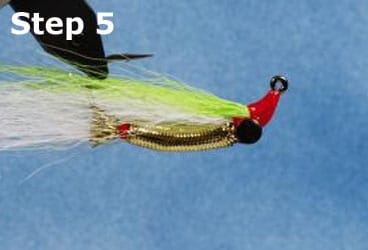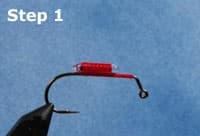
It was an early-November morning on Chesapeake Bay, and Capt. Danny Harrison and I were headed to a spot known for its productive rocks to do some striper fishing. It was a popular place, and a couple of other boats had beat us there, sitting exactly where Harrison said we wanted to be.
But he told me if I could put a cast right up against the rocks, I should get hit. I tied on a new fly I had been working on, and sure enough, on my very first cast, that’s exactly what happened. We motored closer, and it happened again ? and again. By that time, one of the other boats had noticed my bent rod and started to creep around to our side. We took off to the spot they had been fishing, and caught a dozen more stripers in about as many casts.
A month later I was staring at a tangle of mangrove roots in a creek south of Naples, Florida. I put on the same fly I had used in the Chesapeake and started casting right into them. I let it sink briefly before retrieving it, and usually a snook nailed it on the second or third strip.
On both days I fished a fly that is best described as a “happy accident.” It’s a pattern I have come to rely on when the fish are not actively feeding and need to be seduced into biting. I call it the Gonzo because the shape of the nose with the jig hook reminds me of the goofy Muppet. I originally bought the jig hooks because they looked interesting and because I had heard about a few other patterns tied on them. Since I often fish big expanses of off-colored open water, I added a rattle to attract attention. I was right – and wrong.
It was tough to figure out why this fly works so well. I discounted the rattle’s noise as significant, because the best retrieve for this pattern is an extremely slow strip followed by a long pause. However, I know that the rattle needs to be intact for the fly to be effective. So that I could see exactly what the rattle did during a retrieve, I tied several transparent versions of the fly. What I found surprised me. On the long, slow strip, the rattle beads sit at the back of the chamber, and the jig hook causes the fly to rise in a gentle curve. During the pause, the fly levels out, and then the eyes drive the head of the fly downward. As it dips, the beads slide forward in the rattle chamber, and the whole fly darts down and wobbles side to side, re-creating a perfect imitation of a wounded baitfish. I never expected a rattle to produce an action like that.
| The Gonzo has proven itself on myriad fish, including the most popular inshore species, such as striped bass, seatrout, redfish, snook, black drum and tarpon. The fly is extremely durable and fairly weedless because the wing protects the hook point like a bend-back. Just remember that the rattle needs to remain intact for the fly to work properly. The Gonzo is more a technique for creating a balanced rattle fly than a specific pattern, and several modifications suggest themselves. | MATERIALS****__****HOOK: 2/0 Gamakatsu 29112 jig hook THREAD: Fire-orange Danville’s flat-waxed nylon BODY: 4-mm glass rattle covered with large gold Mylar cord EYES: 7¼32-ounce brass eyes WING: Chartreuse-and-white bucktail FLASH: Mixed pearl, copper and gold Flashabou, and Krystal Flash GLUE: Cyanoacrylate, epoxy or Loon HardHead |
The influence of the Clouser Deep Minnow is obvious, and the Gonzo can be similarly modified, including adding a rabbit strip tail or even hackles to make a Half-n-Half-style fly. You can also vary the color, size and wing material. A Gonzo tied on a No. 2 hook with a 3-mm rattle and a Polar Fibre wing proves extremely productive on snook. This fly truly was a happy accident.
| TYING INSTRUCTIONS | |
| Step 1: Start with the thread even with the point of the hook, then wrap it forward the length of the rattle. Place the rattle so that the round end points forward and the back sits even with the point of the hook; wrap the rattle in place. Whip-finish in front of the rattle and then cover the thread wraps with a thin layer of cyanoacrylate. | |
| Step 2: Restart the thread just behind the rattle. Cut a length of Mylar cord long enough to cover the rattle with a little extra on both sides, and remove the core material from it. Slide the Mylar over the rattle and secure it at the rear with a couple of wraps, then whip-finish and glue. Restart the thread in front of the rattle, securing this end of the Mylar cord as well. |
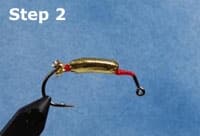
| | Step 3: Hold the brass eyes so that they just touch the front of the rattle and secure with several figure-eight wraps, making sure they are straight. Add a few wraps of thread between the eyes and the rattle to lock them in place, and then glue.|
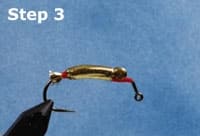
| | Step 4: Turn the fly over. Tie in a small bunch of white bucktail at the bend at the front of hook. Secure this bunch both in front of and behind the eyes. Next, tie in a mixture of 10 to 15 strands of Flashabou and Krystal Flash on top of the bucktail so that it extends 1/4 to 1/2 inch beyond it.|
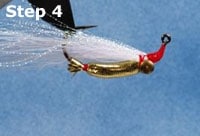
| | Step 5: Place a bunch of chartreuse bucktail just forward of the previous bundle. Make a few loose wraps to hold it in place, but don’t tighten yet. Using your index finger, push the hair down so that it encircles the first bunch of bucktail, and then secure. Build a smooth nose of thread over the ends of the bucktail and whip-finish. Finish with epoxy or Loon Hardhead.|
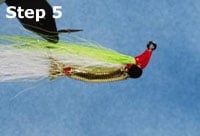
|
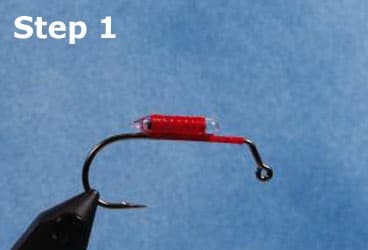
Tying the Gonzo
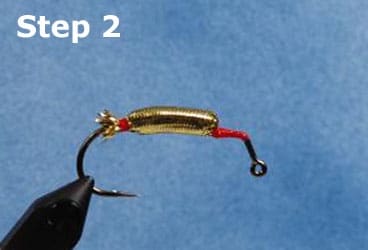
Tying the Gonzo
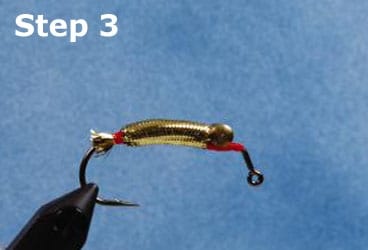
Tying the Gonzo
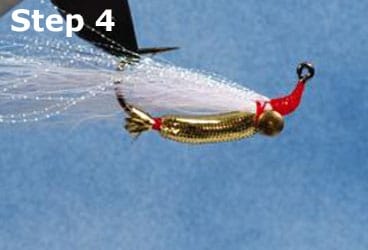
Tying the Gonzo
